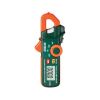Extech MA150 200A Mini AC Clamp Meter + NCV Detector
Features
- Measures DC Current, AC/DC Voltage, and Resistance
- Diode and Continuity test
- Max hold function
- Expedited repair and warranty service
- Lifetime technical support
- More
Overview
The Extech MA120 is a clamp-on meter that measures 200A AC Current up to 100mA resolution. The MA120 also includes a non-contact AC Voltage detector (120/240VAC, 50/60Hz) that provides the user with extra protection and safety because they can detect dangerous voltage before even testing the meter. The 0.7 (18mm) jaw opening is for a 300MCM cable size.
Benefits
Other features include a 2000 count LCD display, built-in white LED flashlight, data hold, auto power off, and overload protection. Additionally, it measures DC current, AC/DC voltage, and resistance, as well as performs diode and continuity tests.
- AC current range: 200A
- AC current maximum resolution: 100mA
- AC current basic accuracy: ±2.5%
- AC voltage: non-contact/600V
- AC voltage maximum resolution: 0.1mV
- Resistance range: 20MΩ
- Resistance maximum resolution: 0.1Ω
- Resistance basic accuracy: ±3.0%
- Dimensions: 7x2.5x1.3" (178x65x32mm)
- Weight: 6 oz (170g)
- (1) Meter
- (2) AAA batteries
- (1) Soft case
In The News
Monitoring Mariculture in the Gulf of Alaska
The mariculture industry in the Gulf of Alaska has been steadily growing in recent years, guided by ongoing research to help refine farm location and cultivation practices. A subset of aquaculture, mariculture focuses on rearing organisms in the open ocean. In Alaska, finfish farming is illegal, so most farms cultivate kelp, oysters, or a combination of the two. These small, locally operated farms started popping up in the Gulf of Alaska in the early 1990s, when shellfish farming first became legal. Kelp farming did not begin to catch on in the state until 2016. Many of the coastal areas that have grown interested in mariculture are historically commercial fishing communities.
Read MoreSupplying Seattle’s Drinking Water: Using Data Buoys to Monitor the Cedar River Municipal Watershed
Providing clean, safe, and reliable drinking water for the 1.6 million people in the greater Seattle area is a top priority for Seattle Public Utilities (SPU). With limited water supplies, SPU dedicates considerable resources to maintain its watersheds and mountain reservoirs. About 70 percent of Seattle Water comes from the Cedar River Municipal Watershed , and the other 30 percent comes from the South Fork Tolt River Watershed . [caption id="attachment_39574" align="alignnone" width="940"] Data buoy in Chester Morse Lake . (Credit: Kevin Johnson / Seattle Public Utilities) [/caption] Jamie Thompson, a fisheries biologist at SPU, monitors aquatic ecosystems centered on fish listed under the U.S. Endangered Species Act (ESA).
Read MoreData-Driven Advocacy on the Lower Deschutes River
Like many freshwater environments, the Deschutes River in Oregon is under pressure from development, pollution, and climate change. Many rivers, streams and lakes in the Deschutes Basin do not meet Oregon water quality standards –where state water quality monitoring assesses levels of bacteria, pH, dissolved oxygen, temperature, and fine sediment. Hannah Camel is the Water Quality Coordinator for the Deschutes River Alliance (DRA), a non-profit organization that focuses on the health of the lower 100 miles of the Deschutes River–the area most affected by human intervention. As a data-driven organization, the DRA has benefited from the installation of two NexSens X2 data loggers.
Read More







